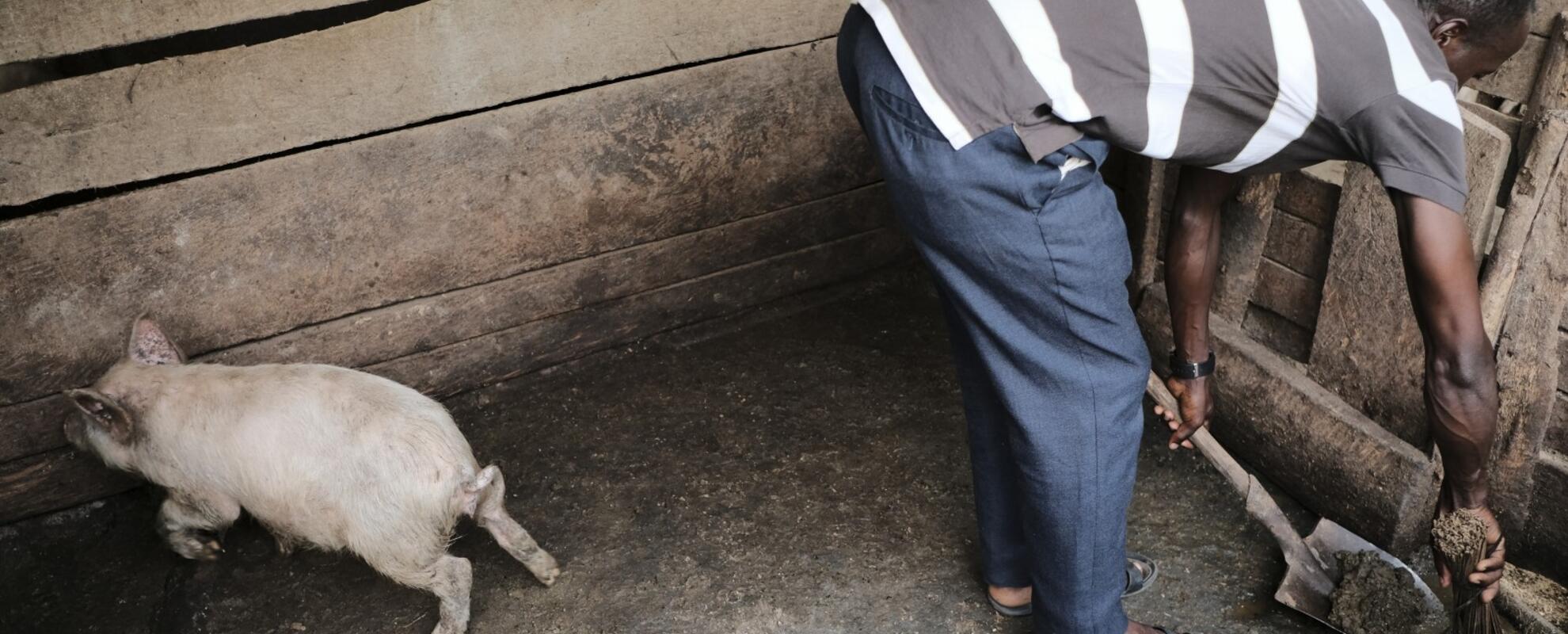
An integrated package to build stronger market systems in Uganda’s Pig Value Chain
With two years left on the clock for the CGIAR Research Program on Livestock, four countries–Tanzania, Uganda, Ethiopia and Vietnam–have been selected as the laboratory to demonstrate how technological and institutional innovations can be integrated into real life interventions.
For Uganda, it was an easy choice to leverage the program’s achievements and work in the country’s pig value chain. The new program aims to create stronger and more profitable market links between farmers and pig market systems and to develop new opportunities and strategies for research on disease perseverance feeds, breeds and environmental issues along the value chain. It builds on previous achievements of the livestock CRP in Uganda, such as enhancing biosecurity capacity to control the spread of animal swine fever, better business and enterprise management, improved marketing and governance issues, alternative feeding options, mapping heat stress areas for pigs and identifying and making available the most appropriate pig breeds.
Why the pig sector?
Pig farming is a profitable enterprise in Uganda. The pig sector is largely dominated by smallholders, who collectively constitute more than 90% of the agricultural system. Smallholders rank pig and crop production as one of the most important sources of livelihood in the country and that also offer opportunities for income generation for women.
Although work by the International Livestock Research Institute (ILRI) and partners under the first phase of the Livestock CRP (under Livestock & Fish) successfully drew the attention of the government, resulting in the implementation of numerous policies to promote the development of the pig industry, there continues to be little attention paid to market systems. This is limiting the sector’s growth potential and production, especially amongst smallholder farmers.
Some of the challenges value chain actors face include the weak collective action by producers, input and service providers and aggregators (who are responsible for coordinating and directing the supply of pigs to markets) in the area of animal health to control the spread of disease, combined with limited knowledge on the use of genetics and feeds to improve production. Public sector involvement is also key to develop policies to regulate health standards and practices, to support market system improvements and to attract private sector investments.
Areas of focus
The Uganda pig value chain program aims to target key market system actors along the value chain, specifically agro-input suppliers, small-scale informal feed producers, pig aggregators and commercial feed producers. The program will be implemented in five districts in Uganda: Kampala, Wakiso, Kamuli, Mukono and Masaka.
The official launch of the new program took place in late 2019 in the country’s capital, Kampala, and brought together scientists, government, research and business actors who are actively engaged in Uganda’s pig sector.
In the 2.5-day event, participants offered insights on the integrated package of interventions that could form the backbone of the project, including the various technologies available for farmers, aggregators, input and service providers. Some of the opportunities discussed were:
- Animal health: there is a need to regulate the use and dispensation of animal drugs and vaccines. It is critical to raise awareness on drug-safety use, the risks of anti-microbial resistance and the need to uphold ethics in order to maintain the quality and health of animals.
- Feeds and forages: farmers’ knowledge on feeding options and practices need to be enhanced. This can be done through proper training on appropriate feeds, to better understand their nutritional values and to formulate feeds that are specific to breeds, age and pig size (especially important for commercial pig farmers). In addition, extension services for smallholder farmers need to be developed and include monitoring and sensitization activities at the district level.
- Environment: farmers require training in better manure management to reduce environmental pollution and use of manure to improve soil fertility.
- Genetics intervention: there is a need to develop standards and systems for improved communal breeding, i.e. testing semen for reproductive diseases, community artificial insemination (IA) and capacity building of AI providers.
Disseminating knowledge and best practices
To generate impact and sustainability, it is imperative that systems be put into place to disseminate knowledge and best practices. Use of smart platforms on mobile devices were identified as a cost-effective and rapid means to bridge knowledge gaps between smallholder farmers and key actors on animal health, feeds and breeding, together with the need to improve access to these services. Several platforms were presented by existing suppliers: Farm radio–an international non-profit radio station that disseminates programs aimed at farming communities; Intervas–a digital service provider for mobile phones that provides bulk sms and payment solutions; and Jaguza–a livestock market and training app in Uganda for smart phones.
The workshop also included discussions on developing technologies and generating knowledge that can be used in the project planning. Iddo Dror, leader of ILRI’s impact at scale program, conveyed the importance of “scaling tools” and laid out the considerations and steps needed in order to scale up a program. These included understanding multiple dimensions of scaling and the significant role non-technical factors with the scaling mindset in project planning; developing realistic ambitions for scaling technologies and pathways to feasible scaling; and identifying key bottle necks and solutions to tackle them.
Monitoring progress
Livestock CRP researchers, under the guidance of priority county leader Ben Lukuyu, will oversee the activities of the project to ensure that it is user-driven, working with the Ministry of agriculture and value chain actors who will be implementing the project. The project aims to be highly collaborative, involving active representation from both government and private sector stakeholders, in order to increase the capacities of key actors along the value chain.





